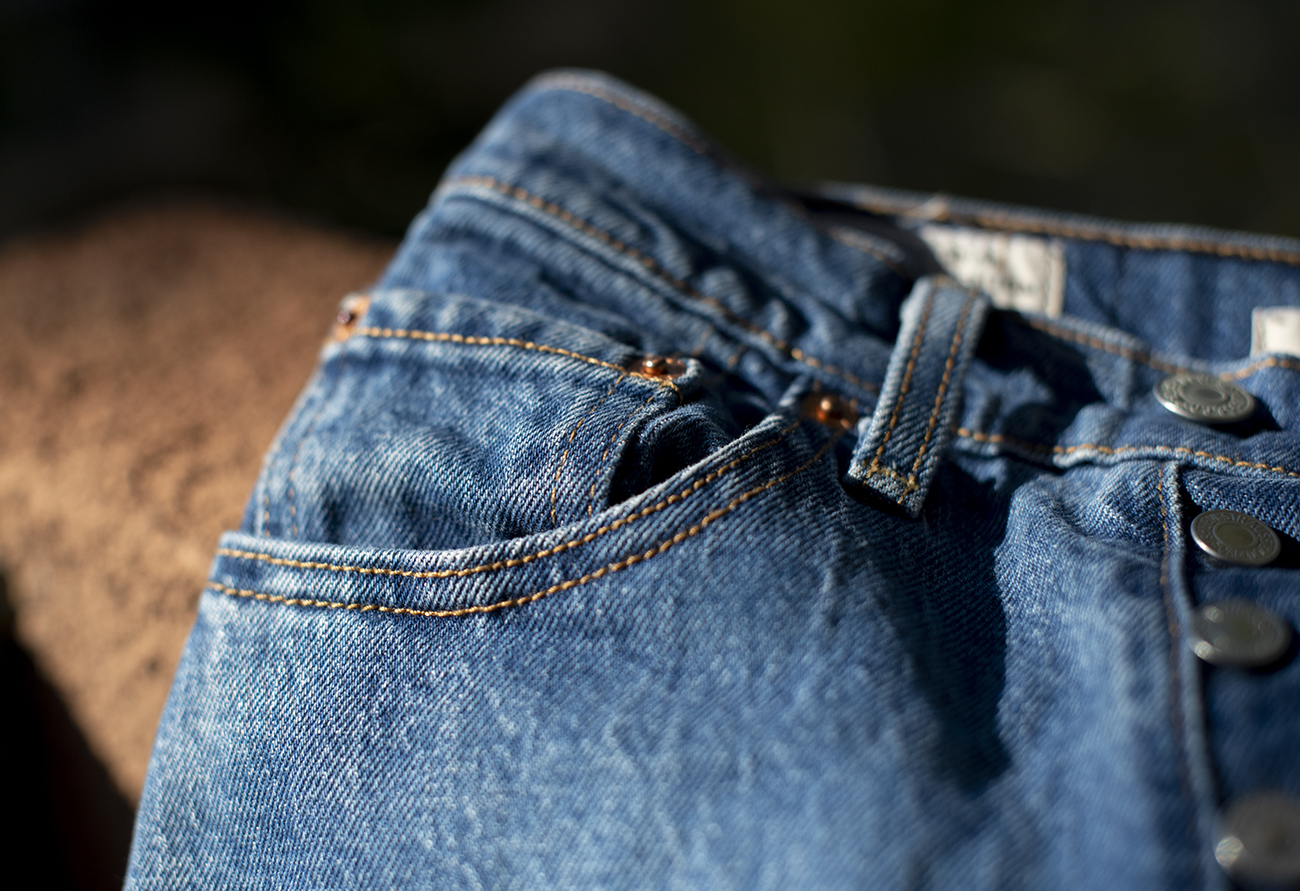The Quad: Bruins find raw stories in history of fading denim

From ripped jeans to bell-bottoms, the use of denim serves as a staple fashion piece. But raw denim – denim prior to any washing or distressing – is something many jean-wearers appreciate the most. (Sakshi Joglekar/Assistant Photo editor)
By Dzuy Nguyen
Feb. 17, 2022 5:11 p.m.
Looking around the Los Angeles community and on campus, it’s apparent that most people own at least one pair of jeans.
Most of the denim sold today is pre-washed and pre-distressed or artificially faded through methods like tumbling jeans with rocks after they’ve been cut and sewn. This process of washing and distressing, called “denim laundering,” occurs in the final stages of jean production.
Without pre-laundering, jeans are more rigid and have not yet faded in the way many modern jeans appear. In this state, denim is “raw.”
Fourth-year business economics student Quinn Simpson said raw denim is underappreciated despite its foundational importance.
“It’s strange that not many people know about raw denim too much. I mean, it’s denim’s original form. It’s the standard. I feel like it should be the norm,” Simpson said.
Matthew Wilson, who runs a YouTube denim channel and denim-centered Instagram account, said pre-laundering denim is a relatively new phenomenon.
“If you go back to when denim was really raw — the only stuff you could buy — there was no such thing as ‘raw’ denim,” Wilson said. “It was just denim. … Jeans were a fashion, yes, but not the denim.”
According to Wilson, in the latter half of the 20th century came a culture shift, in which people wanted denim to be more accessible to the general public. Prior, denim was often associated with masculinity, a viewpoint rooted in Hollywood’s popularization of Western films, where many male actors wore rugged blue jeans.
As the culture shifted, so did the industry. Manufacturers began pre-laundering their jeans with increasing frequency. Pre-laundering is ubiquitous today, as seen in stores like Uniqlo and American Eagle, where jeans have a distinctive “faded” look.
So why do some still prefer raw denim over pre-laundered jeans?
Eliza Aiken, a second-year communication student and director of sponsorships at FAST, UCLA’s only fashion organization, said that unlike pre-laundered denim, raw denim adapts to your body and lifestyle.
“If you’re wearing raw denim jeans, it morphs into your own pair,” Aiken said. “The colors change, it changes in rigidity, and it kind of fits to your body’s form.”
Wilson said denim is made from cotton yarns that are dyed with indigo in a process called “rope dyeing.” The yarns are dipped into a series of indigo baths that make jeans blue, hence the reason jeans fade over time as the dye wears out.
“The thing is, indigo is really not a good dyestuff. It’s really not. It doesn’t stick very well. It doesn’t penetrate very well,” Wilson said.
Wilson added that while the rope dyeing process coats the outside of the yarns in indigo, the yarn’s center stays white, causing jeans to fade. As you wear a pair of raw denim jeans, the points that experience the most abrasion lose their indigo coating the fastest.
For instance, those who use unconventional methods of traveling may experience more worn-out jeans.
“I’m a very keen cyclist,” Wilson said. “Berlin is a very bike-friendly town. You don’t want to drive around here unless you really, really have to. And so, it’s always the crotch of my jeans that’s the first to go. … It’s the first place you’ll see the fades.”
For many jean wearers, raw denim can reflect more than just your own lifestyle. It’s another way of documenting history. Wilson said his jeans share his experience of the pandemic.
“I’ve seen maybe six months’ worth of fades in two years—simply because I’ve been very sedentary for the past two years,” Wilson said.
For FAST, beyond working with denim, the organization highlights the importance of making one’s own clothes, according to the FAST website.
“(FAST members) figure out how to change pieces,” Aiken said. “Or accessorize it to make it look the way they want it to.”
In this light, raw denim is one of the many ways in which one can shape clothing to reflect their identity.
Simpson said while seemingly mundane to most, the distinct fade on each pair of jeans gives them character and often tells a story about the simple blue article of clothing.
“It’s meaningful to know that my jeans reflect my story, not just any story, but my story. To know that my raw denim’s fading documents periods of my life.” Simpson said. “For the longest time, I used to carry a pen in my front pocket. I don’t anymore. But there’s a little fade line that’s still there from the pen’s clip. You know, some might call it a blemish, but when I look at my jeans, that mark means everything to me.”

